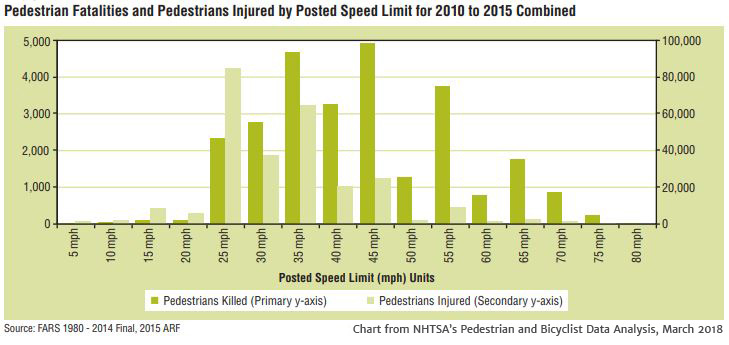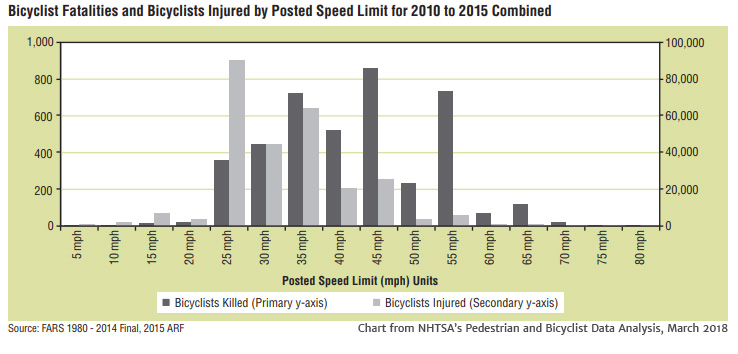
Most cyclist fatalities in urban and rural areas occur in 45 mph zones (link to other blog on fatalities); however, the likelihood of sustaining a survivable injury as a pedestrian or cyclist in a 45 mph zone is not the same.
What is the same is the speed limit where the most injuries occur: 25 mph.
Part of the reason most injuries occur for cyclists and pedestrians in 25 mph zones is the survivability factor. The likelihood of sustaining a serious or fatal injury in a collision with a vehicle as a pedestrian or cyclist goes up dramatically from 18% at 20 mph to 77% at 40 mph (AAA Foundation). Another reason for more cyclist and pedestrian injuries at lower speeds is the increased exposure as there are likely going to be more pedestrians in a 25 mph zone than a 75 mph zone.
The speed limits where the most cyclist and pedestrian injuries occur according to the NHTSA are 25 mph, 35 mph, and 30 mph (in that order). This data is combined for urban and rural areas. Keep in mind that the data for injuries comes from serious injuries which are reported. There may be more injuries occurring than what are reported and would likely be in lower speed zones because of the lack for the need of medical care.


Speeding is Also Responsible for Cyclist and Pedestrian Injuries
The information gathered by the NHTSA, NCSA, FARS, and ARF between 2010 and 2015 relied on speed limits to assume speed for much of their data. Speeding (going over the speed limit) factors into approximately 30% of all motor vehicle fatalities in the United States and is the leading cause of about 8% of pedestrian fatalities. The most common speed limit zone for pedestrian and cyclist fatalities to occur as a result of speeding is 35 mph. Specifics on the number of cyclist and pedestrian injuries that were a direct result of speeding was not published; however, 35 mph is the zone with the second-most injuries for both pedestrians and bicyclists, making it likely that there are a portion of injuries occurring as a direct result of speeding. The unfortunate reality is that speed kills.
Pedestrian Safety
The California Legislature enacted the Pedestrian Safety Act in 2000 which includes new requirements for driver education on pedestrian safety among other items. California Vehicle Code sections 21950-21954 provide legal measures for pedestrian safety and protection, including that drivers have a higher duty of care than pedestrians. And in San Francisco, pedestrian safety is going even further with Vision Zero to bring the number of pedestrian injuries and fatalities to zero. These measures are looking to increase pedestrian safety through more awareness and enforcement in California, including speed-related pedestrian safety issues.

